Harold Davis's Blog, page 63
September 10, 2019
2020 Photographing Flowers for Transparency Workshop with Harold Davis
Please join us for the 2020 session of Photographing Flowers for Transparency with Harold Davis (June 20-21, 2020) to be held in Berkeley, CA. Click here for more information, and here for registration, or contact us for information or registration. Our experience is that this workshop, only given once annually, fills quickly!

September 9, 2019
Dryad and Dark Angel

Dryad © Harold Davis
Dryad and Dark Angel are in-camera multiple exposures using studio strobes and a black background, with some Photoshop post-production work. With Dryad (above), the model used the multiple exposures to intentionally form a tree-like shape. Later, in Photoshop, I added the exterior textures of branches of a tree to give the sense that the model was an exemplar of the divine spirit in a tree, or in other words, a Tree Goddess, a Dryad.
With Dark Angel (below), the wing-like effect around the model’s upper arms was creating when she moved a black, translucent fabric while making the exposures. I positioned her in the frame you can see in Photoshop.
Click here for more of my Multiple Exposure series. The beautiful model for Dryad and Dark Angel, Muirina Fae, was also in Avatar, Devotional Pose, and Vitruvian Woman.
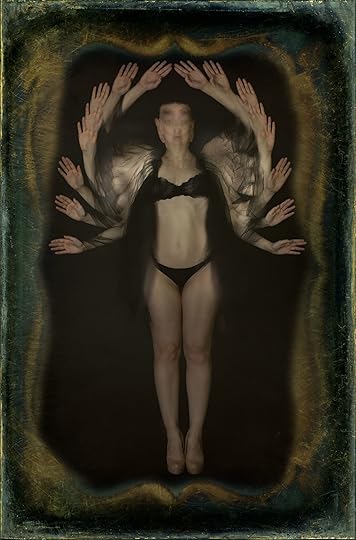
Dark Angel © Harold Davis

September 8, 2019
From the Archives
September 5, 2019
Creative Black and White Opportunities Webinar
The replay of my Creative Black and White Opportunities webinar is now available for viewing on YouTube. I had a bit of problem with managing the software, and got “out of the gate” a little slowly, but if you have patience with the webinar I think you’ll find some worthwhile ideas about creative monochrome.
This webinar was organized and sponsored by Rocky Nook, the publishers of my new book Creative Black & White, 2nd Edition. In this webinar, I discussed the monochrome vision, and tips and tricks related to digital black and white photography, and included material on LAB inversions, solarization techniques, the Karl Blossfeldt effect, and x-ray imaging.
My new book, Creative Black & White, 2nd Edition, is now available. The publisher, Rocky Nook, is offering a 40% discount. Click here to buy Creative Black & White 2nd Ed directly from the publisher. Use the code “HDAVIS40” [no quotes] at checkout to apply the discount (you can also use my discount code for all other Rocky Nook books, by the way!).
Here are the links for my book on Amazon.com and on B&N as well, so the choice of supplier is yours, and here’s the link for the webinar replay on YouTube.
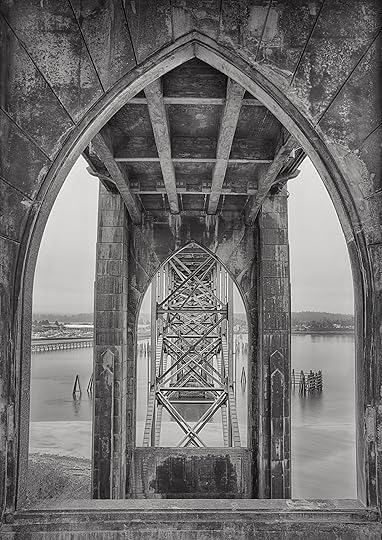
Under the Yaquina Bay Bridge © Harold Davis

September 4, 2019
Photoshop Backgrounds and Textures

Eiffel Tower with texture © Harold Davis
Regarding my LinkedIn Learning Photoshop Backgrounds & Textures course, a correspondent emails: “Thank you for making this topic so interesting. I’ve been accumulating photos of backgrounds and textures for years and have had very little success with using them in my composites. I now understand how they need to be tweaked with opacity and blending modes to get the effects I like….I think you are tops.”
Check out my Photoshop Backgrounds & Textures course to easily add spice, interest, and artistry to your images. My online course is available from LinkedIn Learning a/k/a Lynda.com.

Burning Off the Fog (texturized) © Harold Davis

Spoonerismo
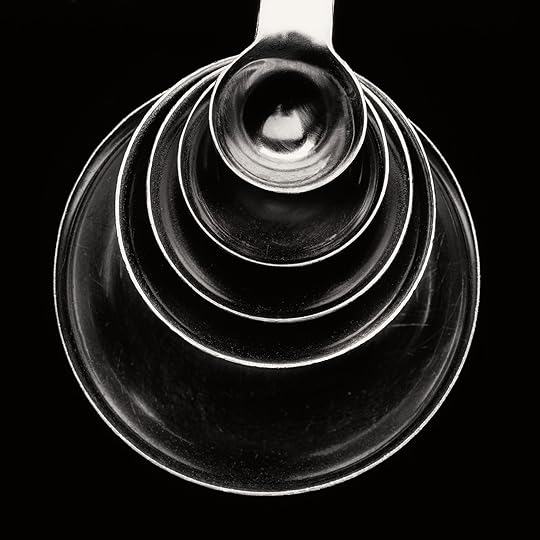
Spoonerismo © Harold Davis
Looking at our sets of kitchen measuring spoons, with their patina and scratches from long use in a hard-working family kitchen, I noticed the pattern of concentric ovals, particularly when each set of spoons was positioned so that light hit the upper edge of each spoon, and was withheld from the concave interiors.
To control the light, and the reflections in the spoon interiors, we lined a large bucket with black velvet, creating a raised stage within the bucket, also on black velvet. This way I was able to control the light coming in across the measuring spoon sets.
For both images I used a 100mm macro lens tripod mounted at f/22 and ISO 64. Each image is combined from eight exposures, with shutter speeds ranging from 1/4 of a second to 30 seconds.

Measuring Spoons © Harold Davis

September 1, 2019
PhotoActive Podcast Interview with Harold Davis
PhotoActive has featured an interview with me in their podcast, Episode 50: Harold Davis Creative Black & White. If you enjoy the chat I have on the podcast with my interlocutors Jeff Carlson and Kirk McElhearn (thanks guys!), you might also find their discussion with Michael Kenna of interest.
Podcast Description: Artist, photographer, and writer Harold Davis joins us to discuss his new book Creative Black & White, 2nd Edition, and we talk about the photographer as artist, and how to see the world in monochrome.
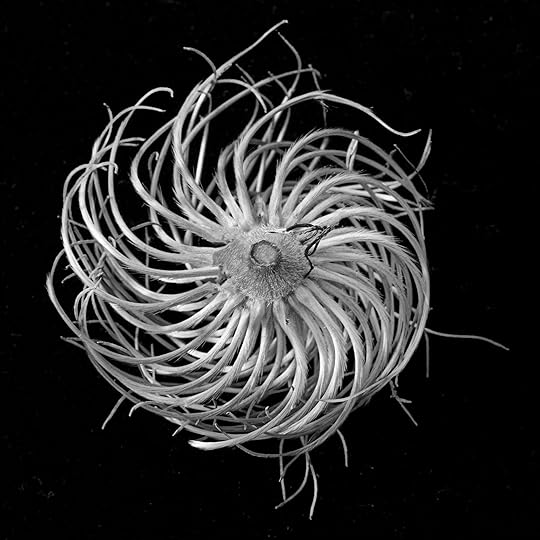
Clematis © Harold Davis
Click here for more about Clematis.
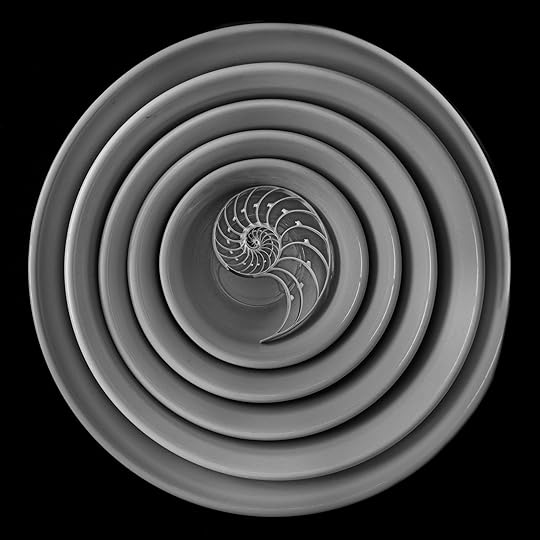
Nesting Bowls and a Nautilus Slice © Harold Davis
Click here for more spirals!
My book, Creative Black & White, 2nd Edition, is now available. The publisher, Rocky Nook, is offering a 40% discount. Click here to buy Creative Black & White 2nd Ed directly from the publisher. Use the code “HDAVIS40” [no quotes] at checkout to apply the discount (you can also use my discount code for all other Rocky Nook books, by the way!).
Here are the links for my book on Amazon.com and on B&N as well, so the choice of supplier is yours. I appreciate your positive and thoughtful reviews on Amazon!

August 31, 2019
Magic in Everyday Things
In the morning, Phyllis called me over. She had the vitamin bottle upended, looking inside for pills she noticed them on the circumference of the circle at the bottom spread out almost like a sparkling kaleidoscope.

Vitamin D3 Bottle from the Inside © Harold Davis
To photograph the effect, Phyllis held the bottle up in the morning sun in our kitchen. I tripod mounted my camera, and used my macro probe lens, with the front optic pushed inside the vitamin bottle like an eyeball on a stalk.
There’s magic in everyday things! I’ve had guesses about what this photograph depicts ranging from the Eye of Sauron (in his cups, towards the bottom of the story) to an operating room light, a package of seeds, and an architectural dome. It’s all in the eye of the beholder. Or is it?

August 30, 2019
Playing with GIFs
Petal Pushing
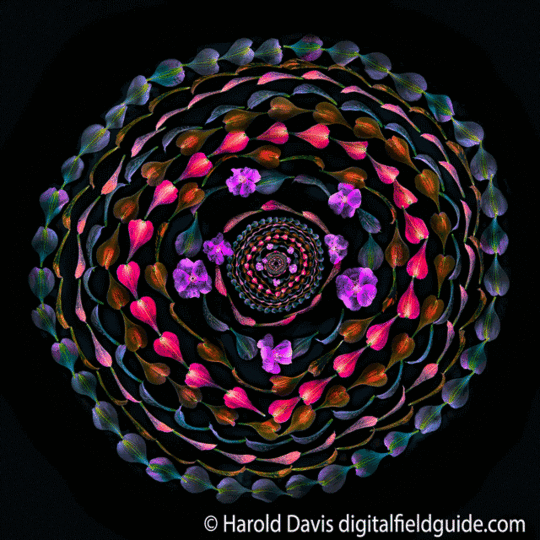
I’m back at my old habits, building compositions constructed from flower petals on a light box, photographing the assemblage in high-key HDR, then combining for transparency in Photoshop, finally inverting using creative LAB color techniques.
Here’s where this composition started:
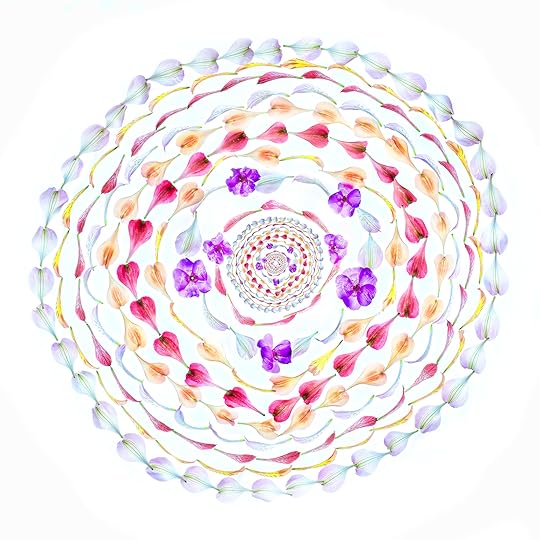
Circular Petal Composition © Harold Davis
When I inverted the composition so it was on a black background, I got the image shown below. My son Julian told me I should turn it into an animated GIF, so I did (shown at the top of this story), using Photoshop wire-frame animation.

Circular Petal Composition Inversion © Harold Davis









